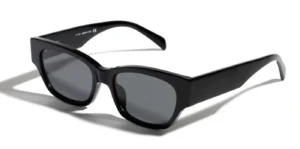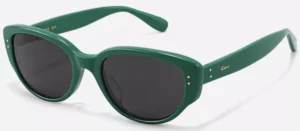Introduction :How to Design Sunglasses Step by Step
Sunglasses are one of the most popular fashion accessories worldwide. But designing a great pair of shades involves far more than just picking nice frames and lenses. Through a methodical design process, you must consider aesthetics, proportions, comfort, performance, trends and practical constraints.
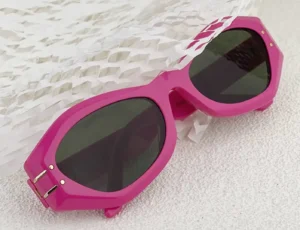
In this comprehensive guide, we (Sunglasses Manufacturers) will walk step-by-step through the complete process of designing stylish, functional sunglasses tailored to your vision. You will learn about:
- Researching the sunglasses market and defining design goals
- Exploring frame shapes, materials, colors, embellishments
- Selecting lens types, treatments, and technologies
- Sketching concepts and translating key features into technical drawings
- Evaluating fit, balance, proportions and sizing for different face shapes
- Prototyping design iterations and conducting user testing
- Ensuring quality optics, UV protection, and durability
- Optimizing manufacturability and cost considerations
- Finalizing technical product specifications for production
- Protecting intellectual property with patents and trademarks
By the end, you will feel equipped to methodically transform your eyewear ideas into manufacturable products ready for market. Let’s get started!
Chapter 2 – Researching the Market and Defining Design Goals
Thorough upfront research establishes the vision for your sunglasses:
- Assess current trends in shapes, materials, embellishments
- Analyze competitor designs and identify gaps or problems to solve
- Survey target demographics to understand style preferences
- Consider branding aesthetics and positioning if an established company
- Determine optional features like polarization, dimensions, interchangeable components
- Define primary goals guiding design like sport performance, fashion, comfort, etc.
- Set pricing parameters based on materials, manufacturing, and market
- Consider distribution models like retail, eyecare professionals, direct-to-consumer
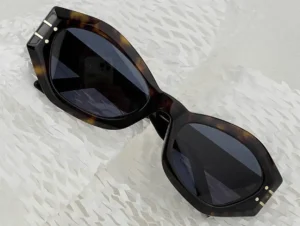
Precisely understood customer needs and context enable crafting differentiated sunglass designs tailored for your objectives.
Chapter 3 – Exploring Frame Shape and Style Options
The frame shape dramatically impacts aesthetics and fit. Considerations include:
- Classic styles like aviators, wayfarers, rounds, ovals, cat eyes
- Mixing retro, modern or futuristic styling cues
- Masculine vs feminine shapes and sizing
- Integrating geometric or ornamental patterns
- Front view proportions and side profile contours
- Accenting design focal points like the brow line or temples
- Creating consistently styled families or collections
- Trending shapes identified in market research
- Limiting overly aggressive or impractical styling
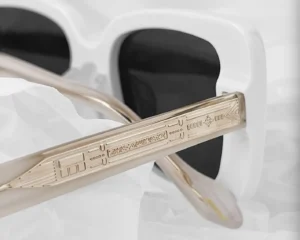
Balance aesthetics with wearability constraints to craft attractive comfortable frames.
Chapter 4 – Selecting Frame Materials and Color Palettes
Materials influence the look, feel and price point:
- Metals like titanium, aluminum, stainless steel, monel
- Plastics such as acetate, propionate, polycarbonate
- Natural materials like wood, leather, bone
- Combinations like wood temples on acetate fronts
- Matte, glossy, or metallic finishes
- Transparency for clear or translucent frames
- Density and thickness factors impacting weight
- Flexibility and durability considerations
- Color palettes including classic neutrals (black/brown), bright accents, gradients
Consider the sensory impression you want the frames to impart when selecting materials.
Chapter 5 – Exploring Lens Options and Treatments
Lens choices optimize visual acuity and protection:
- Clear or tinted lenses to control light levels
- Polarized lenses to cut reflected glare
- Mirror coatings for enhanced aesthetics
- Photochromic lenses that adaptively darken
- Blue-light filtering lenses to protect eyes from screens
- Oleophobic anti-smudge and hydrophobic water resistant coatings
- UVA/UVB protection against the sun’s rays
- Base lens material options like polycarbonate for impact resistance
- Lens thickness profiles and optical qualities
- Prescription compatibility if desired

Combine features balancing visual performance, optical clarity and style.
Chapter 6 – Developing Custom Embellishments
Optional decorative touches provide further distinction:
- Color gradients or patterns like woodgrain
- Metal plating or foil accents
- Laser etching or engraving logos and textures
- Inlaying semi-precious stones or crystals
- Signature shaping like notched temples
- Integrating hinge adornments and medallions
- Hand painting or airbrushing motifs and designs
- Decorative rivets, cutouts, or piercings
- Vintage-style fabric temple tips
- Creative packaging like hard cases or pouches
Subtle embellishments complement frames without overpowering aesthetics.
Chapter 7 – Sketching Initial Concepts and Technical Drawings
Bringing ideas to life on paper is crucial:
- Sketch styling options balancing aesthetics and function
- Highlight or render focal design elements
- Capture views from multiple angles like profiles and top down
- Ensure consistent styling language across frame fronts and temples
- Maintain realistic proportions that suit human anatomy
- Use digital tools to experiment with colors and materials
- Develop technical drawings with dimensions, views, materials, etc.
- Outline visual brand language and styling cues
- Create digital 3D models to preview physical appearance
Iteratively refine sketches, renderings and technical drawings to clearly convey the designs.
Chapter 8 – Evaluating Fit, Proportions and Sizing
Consider ergonomic factors for comfort:
- Target fit demographics like men, women, teens, youth
- Recommend measuring key dimensions like head circumference
- Accommodate variance in nose bridge width and ear position
- Allow adequate length for different face shapes and sizes
- Specify grip shapes and lengths for stable temple holding
- Ensure frames don’t pinch nostrils or bump cheeks
- Test sizing on diverse user groups through prototyping
- Design adjustable components like rubber nose pads
- Specify weight limits to prevent excessive pressure
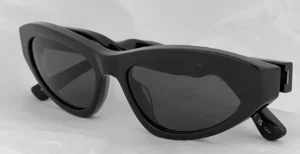
Thoughtful sizing and proportions maximize wearability.
Chapter 9 – Prototyping Design Iterations
Physical prototyping validates concepts:
- Engineer CAD models for 3D printing eyewear or CNC milling
- Review accuracy of shape, dimensions and part fit
- Assess weight, balance and perceived quality
- Make fit adjustments and tweak curvatures
- Evaluate decoration techniques like surface textures
- Perfect technical aspects like hinge friction and flex
- Refine details with each version to finalize design
- Produce molds or tooling once perfected
- Share samples with focus groups for feedback
Repeated small-batch prototyping reduces errors and improves outcomes.
Chapter 10 – Testing and User Research
Trying concepts directly on users is invaluable:
- Recruit diverse survey participants representing target demographics
- Have user groups actually test wearing the prototypes
- Solicit feedback on style, fit, comfort, functionality
- Identify any pressing points, grip slippage, visual obstacles
- Assess fatigue wearing frames for extended intervals
- Evaluate stowing convenience like pocketing arms
- Make fit notes like temple length for different head sizes
- Observe usage behaviors like arm folding frequency
- Document all user research insights to inform refinements
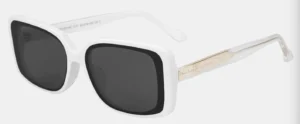
Nothing validates sunglass design like real world testing on actual people.
Chapter 11 – Ensuring Protection and Durability
Core functional requirements include:
- 100% UV protection from harmful rays
- Impact resistance meeting FDA/ANSI standards
- Scratch resistance through coatings
- Materials avoiding skin irritation
- Hinges enduring repeated flexing
- Spring tension providing secure fit
- Reinforced stress points and weld joints
- Corrosion resistance if metal frames
- Thermal stability in hot and cold environments
- Solvent resistance to common cleaners
Rigorous stress testing verifies sunglasses withstand demanding real-world conditions.
Chapter 12 – Optimizing Lens and Frame Manufacturability
Design choices affect manufacturing feasibility:
- Avoiding shapes requiring multi-part molds
- Standardizing screws, pins and fasteners
- Specifying easily workable frame materials
- Designing spring hinges for injection molding
- Minimizing decorative steps requiring secondary processes
- Optimizing lens curvatures for machining efficiency
- Evaluating tooling requirements and costs
- Simplifying assemblies for straightforward production
- Analyzing fabrication time and material waste
- Choosing aesthetics consistent across product families
Simpler, smarter design equates to quicker, cheaper, higher quality production.
Chapter 13 – Finalizing Technical Specifications
Comprehensive technical documentation ensures manufacturability:
- Complete engineering drawings with dimensions and views
- Detailed lens geometry specifications
- Bill of materials listing every component
- Material callouts and treatments
- Decorative process instructions
- Surface finishing requirements
- Assembly sequences and diagrams
- Packaging and case details
- Compliance testing standards
- Quality control expectations
- Approved concept imagery and renderings
- Proprietary markings and confidentiality
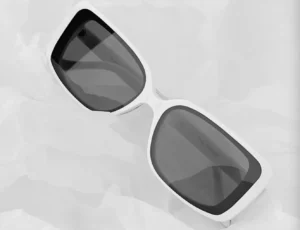
Thorough technical specifications become the manufacturing blueprint.
Chapter 14 – Evaluating Pricing and Costs
Pricing aligns with production expenses and positioning:
- Frame materials and decoration costs
- Lens material and coating costs
- Hinge mechanisms and hardware
- Tooling and mold fees
- Order minimums impact per unit cost
- Assembly and secondary process steps
- Packaging options from pouches to cases
- Target profit margins
- Any import taxes and shipment costs
- Competitor pricing research
Accurately estimating manufacturing costs allows establishing a competitive but profitable pricing strategy.
Chapter 15 – Protecting Intellectual Property
Safeguard patented innovations and brand equity:
- Apply for utility and design patents to protect novel engineering.
- Register trademarks for logos and branding elements.
- Require non-disclosure agreements with manufacturing partners.
- Mark confidential diagrams and specifications.
- Limit distribution of proprietary 3D CAD models.
- Apply holograms and serial numbers to products and packaging.
- Use tracked shipping methods and secure warehouses.
- Monitor ecommerce and social media for counterfeits.
- Take legal action against intellectual property violations.
Vigilance and deterrence helps thwart brand reputational damage from counterfeits.
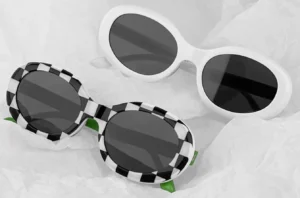
Conclusion
An incredible pair of sunglasses ultimately hinges on meticulous upfront planning and research. By immersing yourself in the competitive landscape, carefully evaluating options, prototyping concepts, manufacturing considerations and protecting IP, you can systematically develop eyewear destined for success. With so many technical, ergonomic and aesthetic factors to juggle alongside business considerations, stunning sunglasses don’t just materialize. They are the result of rigorous data-driven design processes maximizing appeal, quality and value. Methodically follow the right steps, and your shades will be ready to stop traffic.
